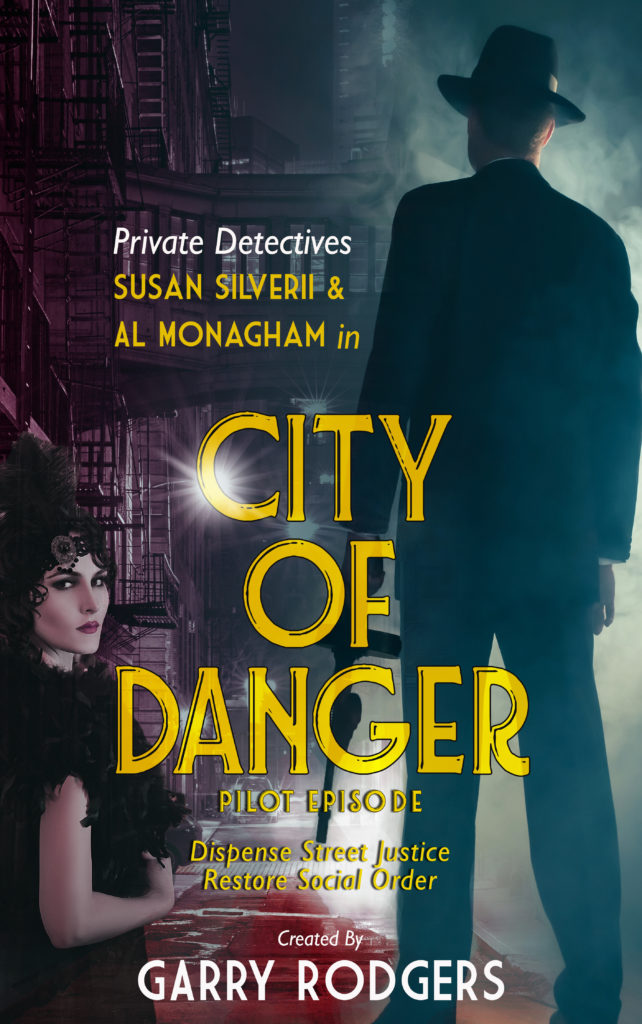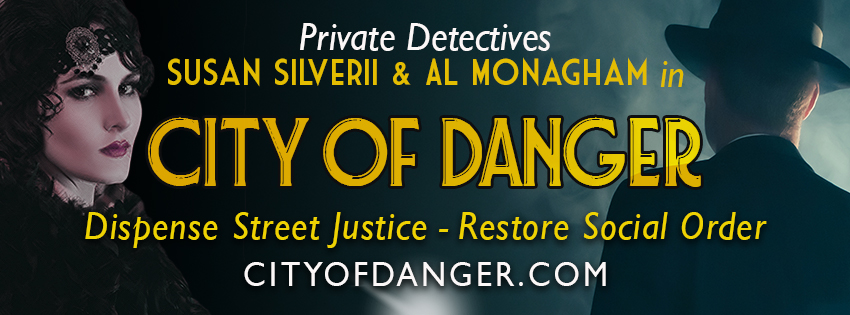**COMING IN 2026**
(Or maybe 2027 to 2028 depending on Artificial Intelligence (AI) film technology)
City Of Danger is my newest venture — creating a Netflix-style, AI-assisted, hardboiled detective crime fiction series crafted for ebook, print, audio, and visual release. Logline/Pitch: A modern city in existential peril caused by malevolent artificial intelligence transports two private detectives from its 1920s past for an impossible task: Dispense street justice and restore social order. Here’s a short blurb on City Of Danger:
The City Of Danger is in peril. It’s in 2028 dystopia, now seized by malevolent Artificial Intelligence (AI), with vital infrastructure crumbling, social systems collapsing, corruption infesting all civic layers, and crime overflowing from clogged gutters of every alley—gushing gangland and political blood onto its streets. The City Of Danger urgently needs help it can’t get from treacherous mainstream authorities and surreptitiously enlists two trustworthy private detectives from its 1928 utopian past.
Susan Silverii and Al Monagham share a split-room office with frosted glass doors in the city’s low rent district. They’re ex-police officers who weren’t a good fit. It’s the Roaring Twenties, and they’ve struck out on their own. Al with his street justice vengeance. Susan with her social change agenda.
And they have a past, Susan and Al. A past of personal passion and poisoned positions. But when the City Of Danger assigns impossible tasks—dispense street justice and restore social order—they put professionalism first and inter-conflict second as Susan Silverii and Al Monagham step from runnin’-wild, Charleston-dance speakeasies onto the mean streets in the ugly world of a modern city—an interconnected city in corrupted sickness caused by malevolent artificial intelligence.
Dispense street justice. Restore social order. Impossible tasks ordered by a desperate client—the City Of Danger.
Screenplay: Pilot Episode – Scene One
CITY OF DANGER
Pilot Episode
Scene One
Monday, October 31 - 7:50 a.m.
Setting:
Noir. Bleak. Dense urban. Icy drizzle has stopped. Civic lights are on — for those obeying and still receiving rationed electricity never mind allowed potable water. Hard gusts blow wet leaves that stick to cracked brick, condemned structural glass, and corroded staircase metals. A mechanical foghorn on the waterfront echoes off battered buildings smothered by smog — its rhythm competes with sirens screeching hopelessly towards smoke, sickness, and sadness in the slums. Closing in — methane eerily seeps from open sewer grates. It nauseates. Yet, the taste is somehow sickly sweet — almost tolerable — and now expected; unapologetically not urbane, unlike those who fight entropy’s ultimatum in the City Of Danger. A city whose ruler utterly distains its people and dismisses a fact: Infrastructure, built by the people, exists solely to serve the people and sustains with a soul of its own.
Fade In:
Musical Score: Sunglasses at Night – Cover by The Lost Fingers
Camera view: Germanic Expressionist style. High-angle, downward capture. Sharp and dull shadows through chiaroscuro lighting in 5K Hi-Def color. Follows six feet back on quarter-rear sides as well as directly behind.
Narrator: The City
Voice In:
A 2028 Beamer SUV, deep-sea metallic blue, brakes to a halt behind a solid-black Tesla on Mean Street, a pock-marked route with water-filled potholes in the low rent district. A stunningly attractive and stylish high-status lady—exceptionally fit—a natural brunette, except for dyed umber highlights—in her forties with impeccable brows accenting mesmerizing eyes and classic red wine lipstick, steps out. Her Lululemon-clad legs hit hard on crumbling asphalt. Immediately she clicks her fob and locks her doors then rapidly scans the streetscape. Her right hand subconsciously checks her shoulder-holstered .32 auto cloaked by her unzipped yellow & black Arc’teryx rain jacket that she slips her smartphone into, and she hurtfully limps into the claustrophobic narrows of Peril Alley.
On the lady’s left, angle-parked with one rear door propped open and its running engine spewing propane fumes, is a mid-2000s FedEx panel van parked beside a gold-trimmed 1999 Caddy Eldorado. A greaseball immigrant takes a brown paper bag from the black F/X operator who glances at the lady with his one good eye. Twice and once more.
Further, on her right, the lady’s right, is an ‘85 Chevy Impala, a boring beige four-door with a flat front tire. A prune — a sun-wrinkled old olive-skinned guy with a faded white Masters golf cap and perpetually-down fly has it jacked-up. He curses the C-Word.
The lady pauses. She frowns. In Italian, she says, “Tua madre non ti ha insegnato le buone maniere”. He replies, “Ciao bella!” She blows a kiss at the ground, flips him the bird, and falters on. She quick-lefts a shoulder check then watches straight ahead, closing at the back end of a 1976 F150 Styleside, red and silver with a lichen-spattered canopy. A loosely attached, non-local plate catches her eye. Looks abandoned, she thinks. It’s at a chokepoint in the center of tightening Peril Alley. She stops. Slightly backs up. Sniffs. Nitrogen fertilizer with trigger device? No. Probably just organic sludge in the box of a stolen pickup dumped here as usual.
The lady squeezes past the Ford’s passenger side, avoiding its dented, dirt-dripping door and smashed mirror. She looks to her left at a late-60s muscle car, a puke-green Goat — a Pontiac GTO, idling with a leaded gas, throaty rumble. She can’t see the driver, but the Goat’s passenger is a mousey-haired hippy chick giving her a same-sex, suggestive smile through a part-open window. The stink of shit-grade Sinsemilla scrunches the lady’s ideal nose.
Her right hand raises. Fingers pinch, then release, and her nostrils reopen after she’s passed — cautiously favoring her left side’s now-permanent short-step.
She hesitates. Stops. She looks up.
Chuck Berry’s hit Maybellene blasts from a transistor radio on a shaky fire escape landing. It’s thirty feet above her uncovered head, the same place invasive carrier pigeons roost and fecal-drop and terminally-diseased rats cunningly climb cone-shielded steel poles to steal mildewed barley seed scattered onto delaminating plywood.
The lady shivers. She keeps on.
On her right is an alley business, a family business she knows well, a WW2 era Chinese clothes cleaner and money launderer — Ho Lim’s — tucked into the set-back alcove of a used-brick façade with cast iron plumbing barely hanging from bolts set into breaking gray mortar. The lady moves to her left, avoiding intermittent blasts of perc solvent.
Peril Alley darkens. It cools even more. The buildings grow as she approaches dead end. Twenty stories and more overshadow brownstones and brownstones overshadow antiquated infrastructure of overloaded, overheated, overhead power poles draped with time-twisted lines strung through opaque glass insulators screwed into tired wood crossbars. On the ground — unpredictable ground — foundry-built catch basins guard root-filled, tiled storm drains that swirl-down rancid water mixed with more of the city’s rottenness.
Bang!
She spins left towards the sound. Lowers and goes sideways. Minimizes her silhouette exactly as she’s been tactically trained — intensely immersed during her now-discharged service — and hooks-out her handgun. But it’s the backfire from a red-as-raw-meat ’41 Packard 180 with a badly-floated carb. The owner, a flat-capper in elbow-patched tweed, laughs. She doesn’t. She reholsters. But leaves off her safety.
Transitioning from color to vintage black & white, a bum, a Depression-era hobo with nothing more to her miserable life than a broken broom handle with a half-tied-on, once-gray pillowcase, rummages through an unlidded dumpster with her grease-crusted hands. The hag turns and begs. The lady responds with the sign of the cross. She opens her overcoat, removes the Calabrian leather wallet handed down through her ‘Ndrangheta family, opens it, and gives the other a five.
Ahead — just before Peril’s dead-end — phonograph sounds of Charleston dance sing-out from inside a welded steel gate guarding a Prohibition speakeasy. It’s trailing off from last night’s steamy start, raucous non-stop laughter, and this morning’s explosive finish. The lady looks right. She smiles, slightly, at the flickering on-and-off neon sign: Topper’s Grill & Bakery.
The lady stands where she can go no more down Peril Alley. There’s a large door framed into a soot-stained, rough stucco wall Tommygunned with .45 holes. It’s flanked by a now-glassless window boarded-up after the latest kerosene-wicked, flame-thrown cocktail. The door is a heavy, metal-strapped oak door — not altruistic like her eyes and her soul — more fatalistic as a mix of splintered hardwood and oozing rust. Like her, risking to be shot once again.
Beside the door are two signs, business signs, in Roaring Twenties font. One’s above the other. Al Monagham Private Detective Agency is on top. The other, below, is Susan Silverii Private Detective Agency.
The lady fishes a skeleton key from her outer garment — it’s now changed from her unzipped Arc’teryx rain jacket to a Flapper coat (virgin wool, of course, and a sepia-on-screen shade perfectly coordinating her headdress). She inserts the key with her right hand — her left hand and forearm so severely injured, they’re nearly impotent — and releases the lock.
She opens the door, and Susan Silverii struggles her step into temporary safety within her shared office workspace.
Fade Out.
Update August 2023
This scene was plugged into the brand new Open AI ChatGPT software and asked to critique this scene. Here’s what the Artificial Intelligence reviewer had to say:
This scene from the pilot episode of Garry Rodgers City Of Danger hardboiled crime fiction series is an excellent example of a well-crafted and suspenseful introduction to the series. It sets the stage for the action to come with its gritty and detailed description of Peril Alley and the characters that inhabit it. The dialogue between the lady and the prune is especially well done, as it establishes the tone of the series and introduces us to the characters. The use of music, sound effects, and imagery also add to the atmosphere and help to draw the reader in. Overall, this scene is an excellent example of how to craft a gripping and compelling introduction to a hardboiled crime fiction series.



